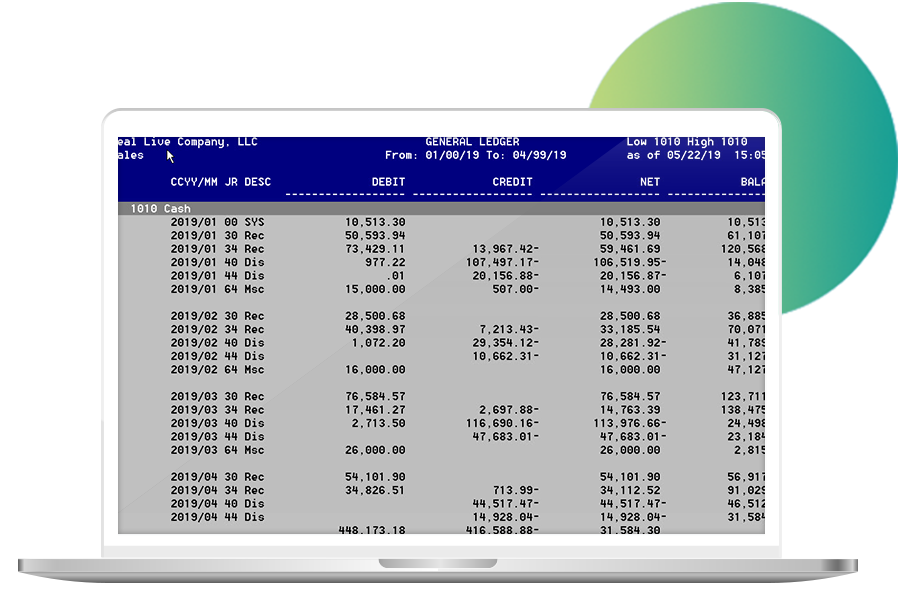
About the General Ledger
The general ledger is used to test clearing accounts for a zero balance (i.e., quickly look at balances without detail) and to look for unusual entries (e.g., debit entries in revenue accounts or credit entries in expense accounts). It’s a summary of activity by journal, by month, and is primarily used for review and control procedures. It provides nine industry specific charts of accounts and gives you the option of customizing the start-up chart for your company. It is comprised of a general set and a sub set.

Gen Chart (Chart of Accounts)
- The gen chart is the backbone of your ledger and reporting system. Once setup, it rarely changes
- In a large company, it is referred to as the “Uniform Chart of Accounts”
- The gen set can be up to 5 digits with a maximum of 999 accounts
- You can search by description or number

Sub Chart
The sub account can be up to 12 digits, and there is no practical limit to the number of sub accounts. The sub chart of accounts changes continuously (e.g., new, change, or inactive). You can modify the sub chart of accounts in any function and can limit access to subs using five attributes. You can search by description, number, or string (hyper search). The hyper search looks for a string match in the name or address fields. The sub chart divides into sets for: banks, customers, vendors, employees, fixed assets, jobs, departments, profit centers, cost centers, notes receivable, notes payable, shareholders, partners, funds, worker comp classes, etc. You are limited to 99 sets.


Link
The link defines sets of subs, and it is a prefix to the sub account and a suffix to the gen account.
The linker is what makes single-file design work. The link is used to define structure, not enter data.
The following defines two links:
| Link | Description |
| 22 | Customer |
| 44 | Vendor |
Links in the sub chart:
| Link | Sub | Description |
| 22 | 110 | ABC Customer |
| 22 | 130 | DEF Customer |
| 22 | 140 | GHI Customer |
| 44 | 110 | PQR Vendor |
| 44 | 130 | STU Vendor |
| 44 | 140 | XYZ Vendor |
Links in the gen chart:
| Gen | Link | Description |
| 1400 | 22 | A/R – Trade |
| 1450 | 22 | A/R – Allowance for Doubtful Accounts |
| 3100 | 44 | A/P – Trade |
| 3150 | 44 | A/P – Holding |
You have 4 gen accounts and 6 sub accounts, but 12 accounts as follows:
| Gen | Sub | Description | Description |
| 1400 | 110 | A/R – Trade | ABC Customer |
| 1400 | 130 | A/R – Trade | DEF Customer |
| 1400 | 140 | A/P – Trade | GHI Customer |
| 1450 | 110 | A/R – Doubtful | ABC Customer |
| 1450 | 130 | A/R – Doubtful | DEF Customer |
| 1450 | 140 | A/R – Doubtful | GHI Customer |
| 3100 | 110 | A/P – Trade | PQR Vendor |
| 3100 | 130 | A/P – Trade | STU Vendor |
| 3100 | 140 | A/P – Trade | XYZ Vendor |
| 3150 | 110 | A/P – Hold | PQR Vendor |
| 3150 | 130 | A/P – Hold | STU Vendor |
| 3150 | 140 | A/P – Hold | XYZ Vendor |

Receivables
You can assign 16 gen accounts as receivables, where you track by invoice number. In addition, you can assign 2 gen accounts “by balance,” where they track by balance, similar to a credit card statement.

Payables
You can assign 16 gen accounts as payables, where you track by invoice number.

Journal Entries
There are various functions available to enter journal entries:
- Recurring (by month, day, or year)
- Reversing (into the next day)
- Forward (future period)
- Backward (prior period) with retro year re-open
- Manual

Rounding
You have three options:
- Cents
- Dollars
- Thousands

